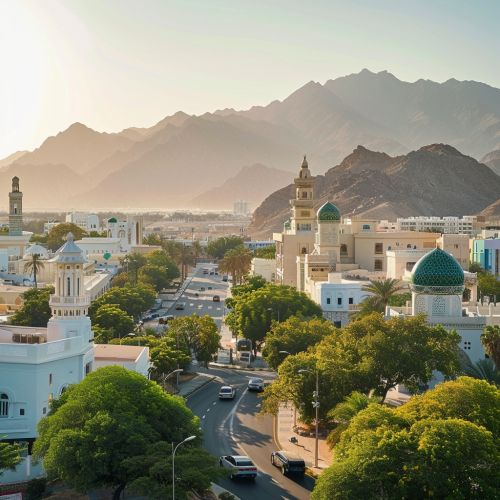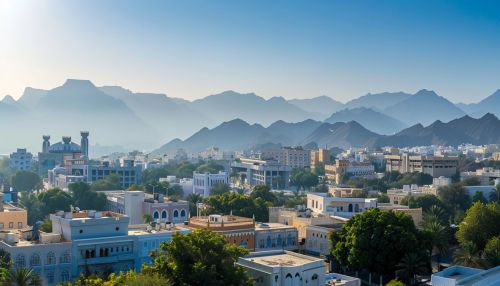Muscat
Geography
Muscat, the capital city of Oman, is located on the Arabian Sea along the Gulf of Oman and is in the proximity of the strategic Strait of Hormuz. It is surrounded by mountains and desert, with the Al Hajar Mountains to the west and the Arabian Desert extending to the east and south. The city spans approximately 3,500 square kilometers and includes six provinces or wilayats.


History
Muscat's history dates back to the 6th millennium BCE, and is one of the oldest cities in the Middle East. The city has been an important trading port between the west and the east since ancient times. It was ruled by various indigenous tribes as well as foreign powers such as the Persians, the Portuguese and the Ottomans at various points in history. In the late 18th century, the Al Bu Sa'id dynasty took control over Muscat and has been ruling Oman ever since.
Economy
Muscat's economy, like that of Oman, is dominated by trade, petroleum, and porting. One of the important economic areas of the city is the Port Sultan Qaboos, which attracts many businesses due to its strategic location. In addition to this, the Muscat Securities Market is the principal stock exchange of Oman. It is a vital tool for the country's financial services sector. The economy has been diversifying into areas such as tourism, real estate and banking.
Culture
Muscat is the heart of Omani culture with numerous cultural sites, museums, and heritage buildings. The city's culture is deeply rooted in the Islamic traditions that shape Oman's way of life. The Royal Opera House and the Sultan Qaboos Grand Mosque are examples of contemporary Islamic architecture. The city is also known for its historic sites like forts, castles, towers and walls, the most famous being the Al Jalali and Al Mirani forts.
Demographics
The majority of the population in Muscat are Arabs, followed by South Asians, Balochis, and Africans. Arabic is the official language of Oman, and thus is widely spoken in Muscat. English is also widely spoken, and is used as a business language. Islam is the predominant religion of the city, with majority of the people following the Ibadi sect of Islam.
Climate
Muscat has a hot desert climate with high temperatures during summer and mild winters. Rainfall in Muscat is minimal and averages only about 10 cm (3.9 in) a year. The coolest temperatures in the city are usually experienced in January, and the hottest in June. The city experiences a seasonal khareef (monsoon) from June to September.
Education
Muscat is home to a number of universities and other institutions of higher education. The Sultan Qaboos University, established in 1986, is the oldest and most prestigious university in the city. Other universities include the University of Nizwa and the Muscat University. The city also has a number of international schools catering to various expatriate communities living in the city.
Transportation
Muscat has a well-developed transport infrastructure with a large network of roads connecting the city with other regions of the country. The Muscat International Airport is the main international gateway to the city and the country. The city also has a public transport system, which includes buses and taxis.
